
Brightest comet in 27 years!!
In case you haven’t heard … Comet C/2023 A3 (Tsuchinshan-ATLAS) – aka Comet A3 – is in the evening sky! And it’s the brightest comet in 27 years, the brightest since Hale-Bopp in 1997. Look to the right of the bright planet Venus for Comet A3’s long wispy tail. Read and find more charts: Can you see Comet A3 Tsuchinshan-ATLAS with the unaided eye?
Our charts are mostly set for the northern half of Earth. To see a precise view – and time – from your location, try Stellarium Online.

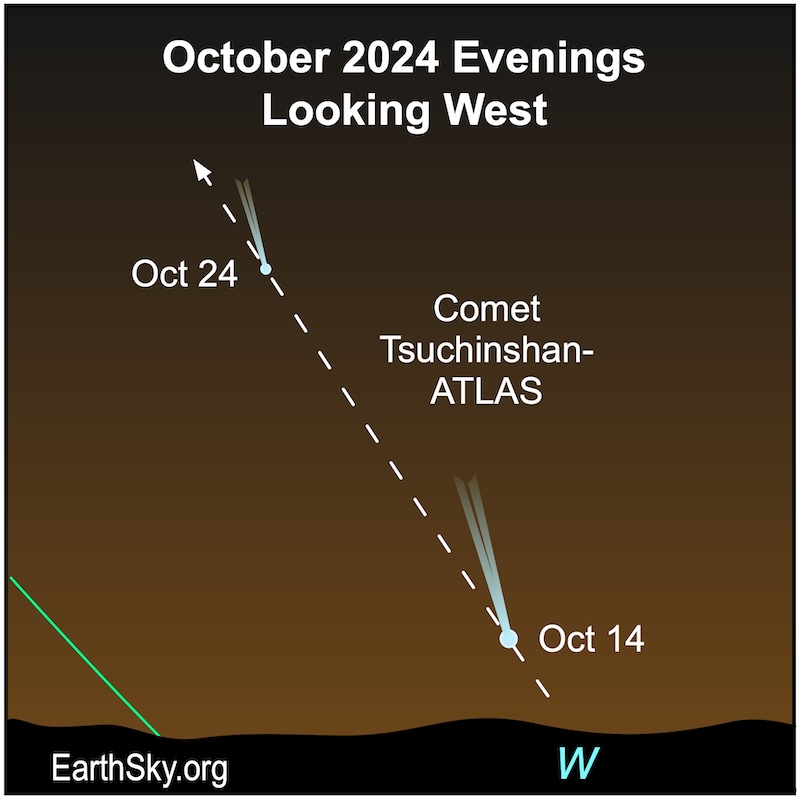
Comet A3 and its anti-tail, October 13-15
Comet A3 has an anti-tail! Can you see it? An ordinary comet tail always points away from the sun. That’s because comet tails are created by the pressure of solar radiation and by the solar wind streaming from our star. But – during the period of October 13 to October 15, as we cross the plane of the comet’s orbit – Comet A3 is exhibiting a rare anti-tail as well. The anti-tail points toward the sun. Read about the anti-tail – and see photos – here.
Victor Rivera in Puerto Rico captured this rare footage of the anti-tail of Comet A3 on October 13, 2024.
We might have 2 comets
Stay tuned, because we might have another bright comet toward the end of October. EarthSky’s Deborah Byrd, Dave Adalian and Marcy Curran have more in the video below.
Here’s the lowdown on not one comet – but two comets – possibly visible in Earth’s skies in October and early November 2024. EarthSky’s Deborah Byrd, Marcy Curran and Dave Adalian have you covered! On October 8, astronomers said the 2nd comet, S1, might be disintegrating. More on that here.
Look west after sunset for Comet A3
In September and early October – for Southern Hemisphere observers with dark skies and good optical aid – Comet C/2023 A3 (Tsuchinshan–ATLAS) put on a fantastic show in the morning sky. Amazing images of A3 in the morning here. Then A3 was lost in the sun’s glare for a few days. Now it’s back, quite low along the western horizon as soon as the sun disappears!
Every evening now, Comet A3 will appear a bit higher from the western horizon, in the hour or so after sunset. Its perihelion (closest point to the sun) was September 27. And its closest point to Earth was October 12. So it’s now moving away from us, and thereby getting fainter. And yet, in the days ahead, the comet should be easier to see than it was for its morning appearance last month. That’s because many comets are brighter after perihelion. And it’s because the comet will be farther each evening from the sun’s glare.
Here are some images from the EarthSky community.
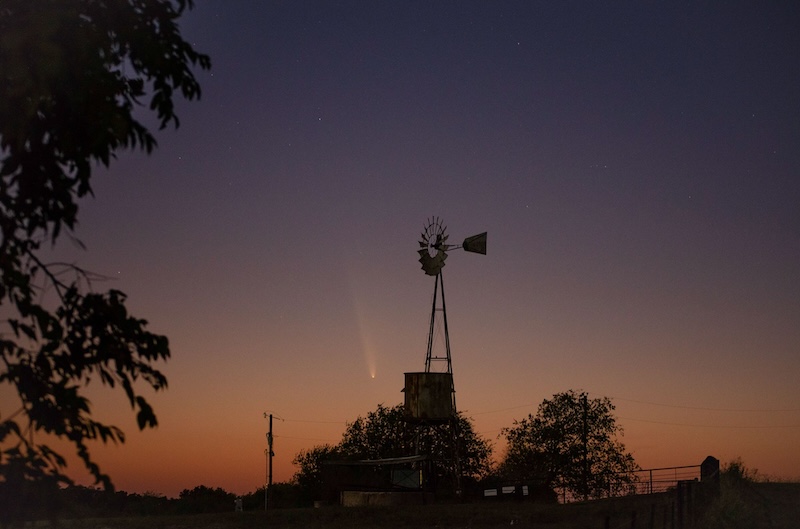
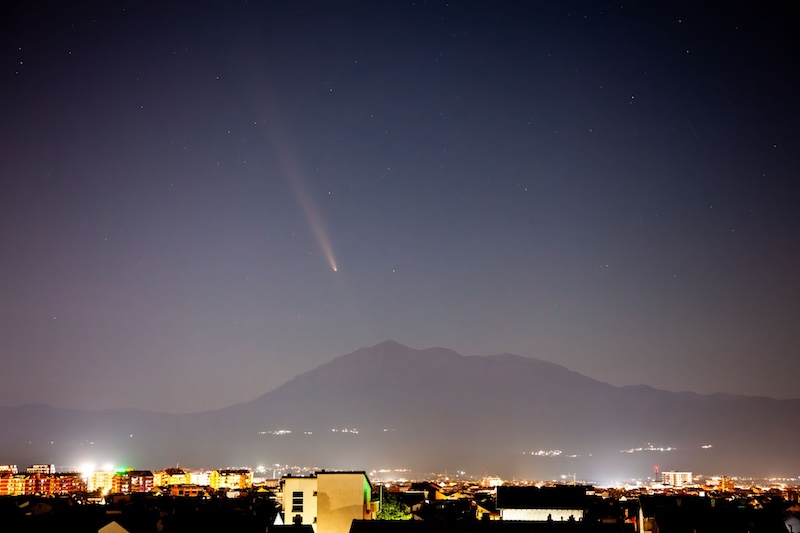

Before this, the comet was in the sun’s direction
The comet was closest to Earth in its orbit on October 12, 2024. At that time, it was between us and the sun, putting on a heck of a show in solar telescopes. And some people even managed to catch it near the sun. See images below.
What a week. Comet C/2023 A3 Tsuchinshan-ATLAS was the brightest comet since P1 McNaught to cross the view of SOHO’s LASCO C3 imager this past week… and the show’s not over. Starting this weekend, the comet begins its encore presentation, appearing low to the west at dusk. pic.twitter.com/nPtwz8MckY
— Dave Dickinson (@Astroguyz) October 11, 2024
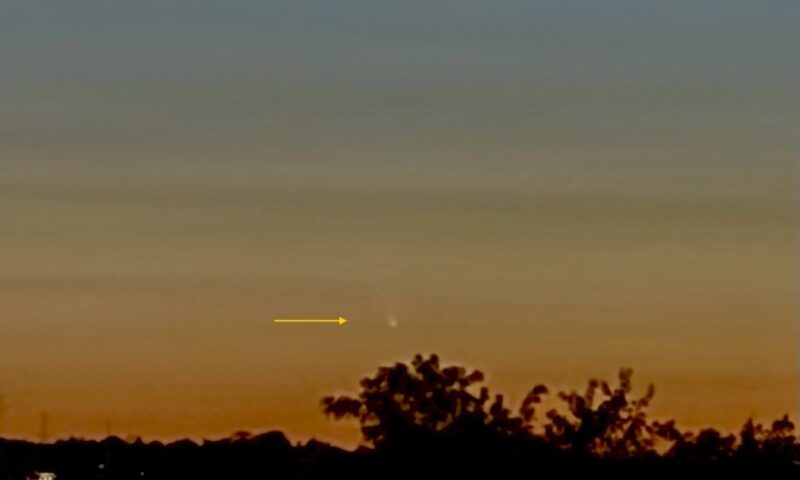
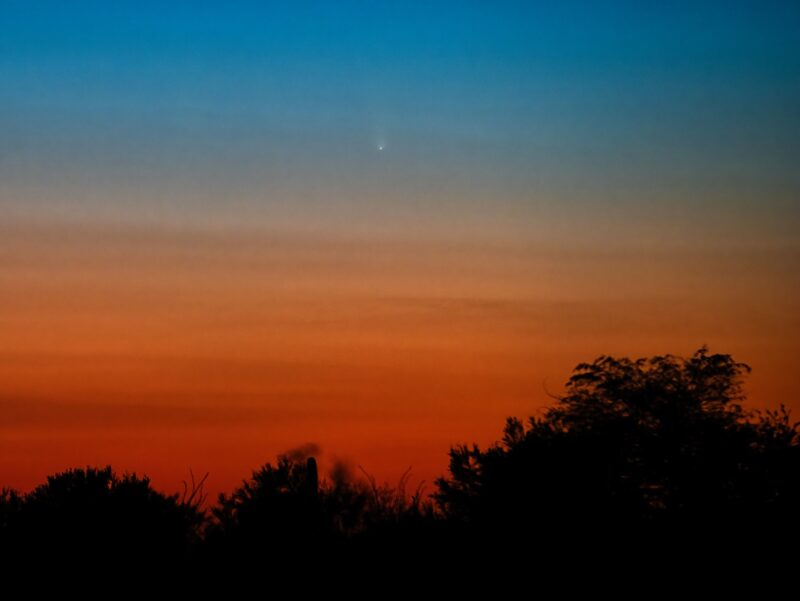
Comet A3’s orbit around the sun

Around October 17 …

How bright? How easy to see?
Comets are unpredictable. And Comet A3 isn’t going to be a Comet of the Century. But if it continues to perform well, it might be the brightest comet of the year … except for one other possibility.
There is a second comet in Earth’s skies that might become bright, if it’s not disintegrating. The ATLAS telescope also discovered Comet C/2024 S1 (ATLAS). It’s what’s known as a sungrazer. It was first given the designation of A11bP7I, but now it’s officially C/2024 S1 (ATLAS) … or Comet S1 for short. Predictions for the comet had it reaching as bright as magnitude -5 to -7 around October 28. But on October 8, astronomers reported it might be breaking up. Read more about its rumored disintegration here.

Helpful tips to spot a comet
1. Be sure you’re looking at the correct direction and time. Comet A3 will be visible low in the west after sunset beginning around October 14. Comet S1, if it holds together, will be visible in late October to early November, low in the east before sunrise.
2. You need a dark, unobstructed sky. Start looking when the sky is dark, but close to sunrise or sunset. Make sure there aren’t hills, trees or buildings blocking your view.
3. If you can’t see the comet with your eye, try your phone. Most cell phone cameras provide a night or low-light mode. But capturing an image of the comet will require that you hold the camera firmly – or lean against a fixed object like a tree – to avoid shaky or blurred images. Try taking a few pictures facing west after sunset (for Comet A3) or east before sunrise (for Comet S1). These images accumulate the light for a few seconds, so you might be able to catch the comet in your images, even if you can’t see it with the eye.
4. AFTER you’ve located the comet, use binoculars or your eyes to sweep in that area in the sky. You might discover that, in fact, you can see both the comet and its tail with your eye alone.
5. If you see it, try taking your own measurements of the comet’s tail. For example, if you take a good look through a pair of binoculars that has a 5-degree field of view, and you can see the tail extending about 3/5 of that field, you’re seeing around 3 degrees of the tail. And that means you are seeing with your own eyes a cometary tail that looks as long as six moon diameters!
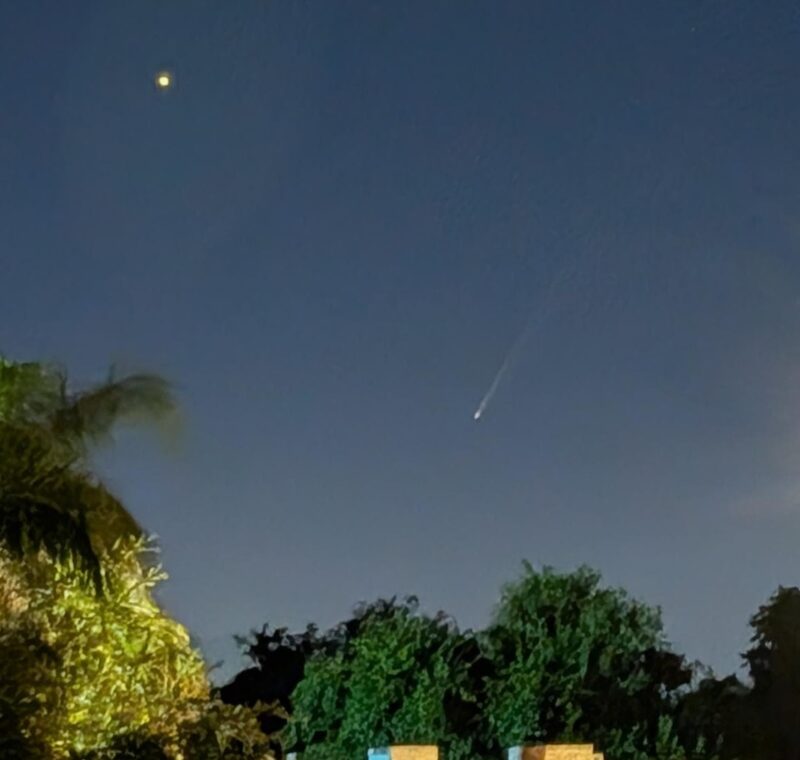
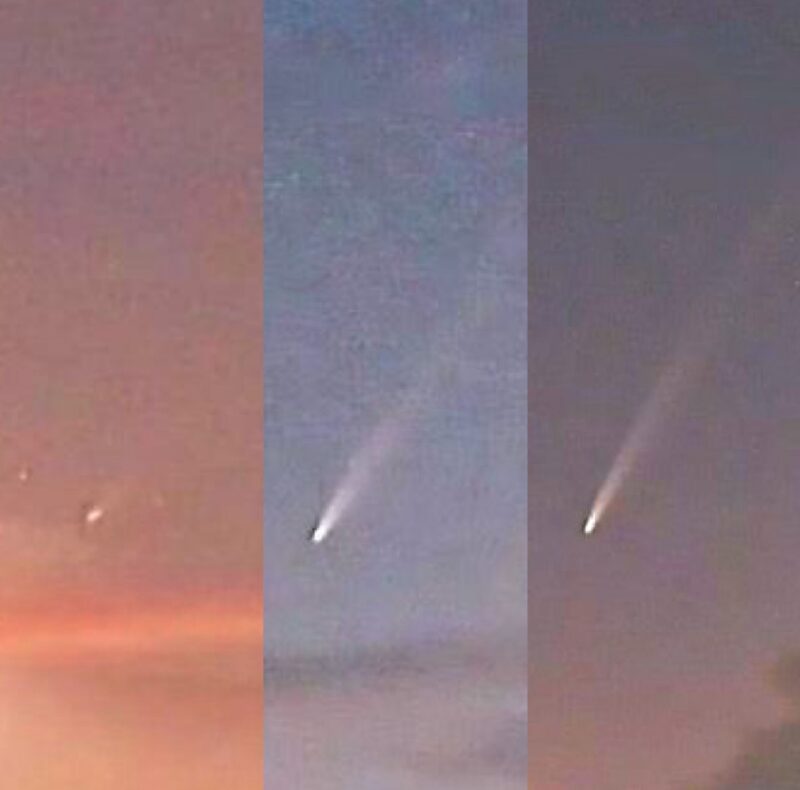
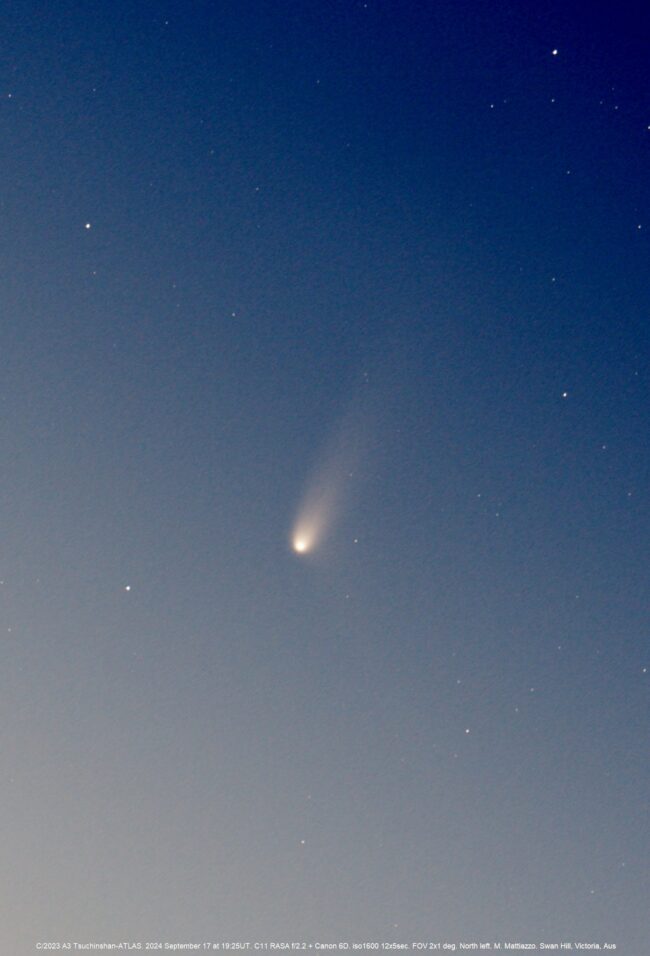
Discovery and naming
The Asteroid Terrestrial-impact Last Alert System (ATLAS) telescope in South Africa discovered Comet C/2023 A3 on February 22, 2023. Additionally, observers at Purple Mountain (Zijin Shin or Tsuchinshan) Observatory in China found the comet independently on images from January 9, 2023. Therefore, the comet also has the nickname Tsuchinshan-ATLAS.
At discovery, the comet was still 7.3 astronomical units (AU) from the sun, and shining at a dim magnitude of 18.
Preliminary analysis of its trajectory suggests Comet A3 completes an orbit around the sun every 80,660 years. However, that doesn’t mean it’s been here before or will be back in 80,000 years. According to Karl Battams, a scientist who works on the SOHO/LASCO and Sungrazer Project for the U.S. Naval Research Laboratory, the comet is most certainly dynamically new from the Oort Cloud and it’s not possible to model back if it had been near the sun in the ancient past. Battams also said:
Its orbit has now been tweaked (shortened) by the sun but still is absurdly long, and puts it back out into the Oort Cloud where, more than likely, it’ll get nudged again by a passing star system, and will never return. … So Neanderthals definitely did NOT see this comet, and some distant alien civilization is more likely than humans are to see it.
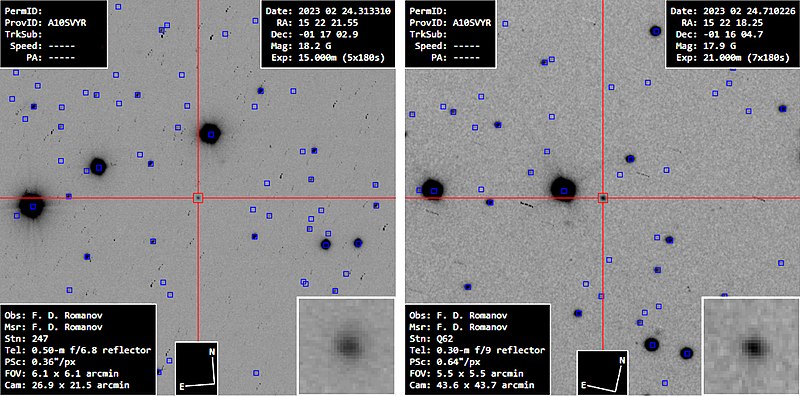
Comet A3 in social media
This is an absolutely amazing simulation of the behavior of Comet C/2023 A3 (Tsuchinshan-ATLAS) by @nlefaudeux ? #Comet #Astronomy #TsuchinshanATLAS #Cometa #CometC2023A3 #Tsuchinshan #C2023A3 #FollowTheComet pic.twitter.com/lpAWezXzp4
— Yuri Beletsky (@YBeletsky) September 27, 2024
Getting up at 4am to see Comet Tsuchinshan-ATLAS rising over the Toowoomba range
— George Zhou (@georgezhouastro.bsky.social) September 22, 2024 at 3:54 PM
Comet C/2023 A3 (Tsuchinshan-ATLAS) is finally here ! ???I captured this image this morning at 09:22 UTC from @LCOAstro in Atacama desert in Chile ?? The view was absolutely spectacular ! The clouds were constantly moving just above the horizon, but we got really lucky when the… pic.twitter.com/AoClHkatFr
— Yuri Beletsky (@YBeletsky) September 24, 2024
So far Comet Tsuchinshan-ATLAS looks like a fuzzy star to the naked eye looking out the cupola windows. But with a 200mm, f2 lens at 1/8s exposure you can really start to see it. This comet is going to make for some really cool images as it gets closer to the sun. For now a… pic.twitter.com/JstaSLJ4Ui
— Matthew Dominick (@dominickmatthew) September 19, 2024
It’s already possible to barely see the Comet C/2023 A3 (Tsuchinshan-ATLAS) from northern locations but faint and very very low over the horizon.
Inages:
Left: 21/9/24 by Val Italo from Atlanta, USA
Right: 22/9/24 from Canary Islands by Frank A. Rodríguez @AstroEduca pic.twitter.com/Kh1WqDhx5K— Xavi Bros (@Xavi_Bros) September 23, 2024
Bottom line: Look for Comet A3 Tsuchinshan-ATLAS in the evening sky, west after sunset. Get tips and star charts here. If you catch an image, submit it to EarthSky!
Source: Inevitable Endgame of Comet Tsuchinshan-ATLAS (C/2023 A3)











